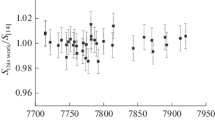Abstract
Absorption spectroscopy, which is widely used for concentration measurements of tropospheric and stratospheric compounds, requires precise values of the absorption cross-sections of the measured species. NO2, O2 and its collision-induced absorption spectrum, and H2O absorption cross-sections have been measured at temperature and pressure conditions prevailing in the Earth’s atmosphere. Corrections to the generally accepted analysis procedures used to resolve the convolution problem are also proposed.
Similar content being viewed by others
References
Camy-Peyret, C.;Bergquist, B.;Galle, B.;Carleer, M.;Clerbaux, C.;Colin, R.;Fayt, C.;Goutail, F.;Nunes-Pinharanda, M.;Pommereau, J.P.;Hausmann, M.;Platt, U.;Pundt, I.;Rudolph, T.;Hermans, C.;Simon, P.C.;Vandaele, A.C.;Plane, J.;Smith, N. (1996): Intercomparison of Instruments for Troposheric Measurements using Differential Optical Absorption Spectroscopy. J. Atm. Chem. 23, 51–80
Plait, U.;Perner, D.;Pätz, H. (1979): Simultaneous measurement of atmospheric CH2O, O3, and NO2 by differential Optical Absorption. J. Geophys. Res. 84, 6329–6335
Solomon, S.;Schmeltekopf, A.L.;Sanders, R.W. (1987): On the interpretation of zenith sky absorption measurements. J. Geophys. Res. 92, 8311–8319
Ramanathan, V.;Vogelmann, A.M. (1997): Greenhouse effect, atmospheric solar absorption and the Earth’s radiation budget: from the Arrhenius-Langley era to the 1990s. Royal Swedisch Academy of Sciences 26, 38–46
Arking, A. (1996): Absorption of solar energy in the atmosphere: discrepancy between model and observations. Science 273, 779–782
Erle, F.;Pfeilstjcker, K.;Platt, U. (1995): On the influence of tropospheric clouds on zenith-scattered-light measurements of stratospheric species. Geophys. Res. Lett. 22, 2725–2728
Wagner, T.; Bosch, H.; Funk, O.; Leue, C.; Pfeilsticker, K.; Platt, U. (1997): Cloud properties deduced from GOME O2- and O4- observations. Polar stratospheric ozone 1997, Schliersee, Germany, 22–26 September, p. 514–517
Vandaele, A.C.;Hermans, C.;Simon, P.C.;Van Roozendael, M.;Guilmot, J.M.;Carleer, M.;Colin, R. (1996): Fourier Transform Measurement of the NO2 Absorption Cross-sections in the Visible Range at Room Temperature. J. Atm. Chem. 25, 289–305
Lux, J.P.;Coquart, B. (1989): A cooled multipass cell for the absorption study of atmospheric compounds. J. Phys. E: Sci. Instrum. 22, 967–968
Lux, J.P.;Jenouvrjer, A. (1985): Réalisation d’une cellule d’absorption à réflexions multiples de grande dimension (longueur: 50 m). Revue Phys. Appl. 20, 869–875
Vandaele, A.C.;Hermans, C.;Simon, P.C.;Carleer, M.;Colin, R.;Fally, S.;Mérienne, M.-E.;Jenouvrier, A.;Coquart, B. (1997): Measurements of the NO2 Absorption Cross-section from 42000 cm1 to 10000 cm1 (238-1000 nm) at 220 K and 294 K. J. Quant. Spectrosc. Radiat. Transfer 59, 171–184
Bates, D.R. (1989): Oxygen band system transition arrays. Planet. Space Sci 37, 881–887
Hasson, V.;Nicholls, R.W. (1971): Absolute spectral absorption measurements on molecular oxygen from 2640-1920 Å: I. Herzberg I (A 3S+u-3S-g) bands (2640-2430 Å). J. Phys. B: Atom. Molec. Phys. 4, 1778–1788
Huestis, D.L.;Copeland, R.A.;Knutsen, K.;Slanger, T.G.;Jongman, R.T.;Boogaarts, M.G.H.;Meijer, G. (1994): Branch intensities and oscillator strengths for the Herzberg absorption systems in oxygen. Can. J. Phys. 72, 1109
Kerr, C.M.L.;Watson, J.K.G. (1986): Rotational line strenghts in3Δ-3σ electronic transitions. The Herzberg III system of molecular oxygen. Can. J. Phys. 64, 36–44
Yoshino, K.;Esmond, J.R.;Murray, J.E.;Parkinson, W.H.;Thorne, A.P.;Learner, R.C.M.;Cox, G. (1995): Band oscillator strengths of the Herzberg I bands of O2. J. Chem. Phys. 103, 1243–1249
Wulf, O.R. (1928): A progression relation in the molecular spectrum of oxygen occurring in the liquid and in the gas at high pressure. Proc. Nat. Acad. Sci. (US) 14, 609–613
Finkelnburg, W.;Steiner, W. (1932): Uber die absorptionsspektren des hochcomprimierten Sauerstoffs und die Existenz von O4-Molekulen. Z. Phys. 72, 69–88
Shardanand, R. (1969): Absorption cross-sections of O2 and O4 between 2000 and 2800 Å. Phys. Rev. 186, 5–9
Krupenie, P.H. (1972): The spectrum of molecular oxygen. J. Phys. Chem. Ref. Data 1, 423–534
Blake, A.J.;McCoy, D.G. (1987): The pressure dependence of the Herzberg photoabsorption continuum of oxygen. J. Quant. Spectrosc. Radiat. Transfer 38, 113–120
Shardanand, R. (1977): Nitrogen-induced absorption of oxygen in the Herzberg continuum. J. Quant. Spectrosc. Radiat. Transfer 18, 525–530
Bernath, P.;Carleer, M.;Fally, S.;Jenouvrier, A.;Vandaele, A.C.;Hermans, C.;Mérienne, M.-E.;Colin, R. (1998): The Wulf bands of oxygen. Chem. Phys. Letter 297, 293–299
Tabisz, G.C.;Allin, E.J.;Welsh, H.L. (1969): Interpretation of the visible and near-infrared absorption spectra of compressed oxygen as collision-induced electronic transitions. Can. J. Phys. 47, 2859–2871
Blickensderfer, R.P.;Ewing, G.E. (1969): Collision-induced absorption spectrum of gaseous oxygen at low temperatures and pressures. I. The1Δg <-3Σg− system. J. Chem. Phys. 51, 873–883
Blickensderfer, R.P.;Ewing, G.E. (1969): Collision-induced absorption spectrum of gaseous oxygen at low temperatures and pressures. II. The simultaneous transitions1δg +1δg <-3Σg− +3Σg and1δg +3Σg+ <- +3Σg− +3Σg J. Chem. Phys. 51, 5284–5289
Dianov-Klokov, V.I. (1964): Absorption spectrum of oxygen at pressures from 2 to 35 atm in the region from 12600 to 3600 Å. Opt. Spectrosc. 16, 224–227
Dianov-Klokov, V.I. (1966): Absorption spectrum of condensed oxygen in the 1.26-3 μ region. Opt. Spectrosc. 20, 530–534
Herman, L. (1939): Spectre d’absorption de l’oxygène. Ann. Phys. 11, 548–611
Osterkamp, H.; Ferlemann, E.; Harder, H.; Perner, D.; Platt, U.; Schneider, M.; Pfeilsticker, K. (1997): First Measurement of the Atmospheric O4 Profile. Polar stratospheric ozone 1997, Schliersee, Germany, 22–26 September, p. 478–481
Perner, D.;Platt, U. (1980): Absorption of light in the atmosphere by collision pairs of oxygen (O2)2. Geophys. Res. Lett. 7, 1053–1056
Greenblatt, G.D.;Orlando, J.J.;Burkholder, J.B.;Ravishankara, A.R. (1990): Absorption measurements of oxygen between 330 and 1140 nm. J. Geophys. Res. 95, 18577–18582
Van Roozendael, M. (1998). Personal communication
Van Roozendael, M.; Lambert, J.C.; Roscoe, H.K. (1998): Temperature dependent spectral resolution effects in SAOZ UV-visible spectrometers. SCUVS III Workshop, Paris (France), 28–30 April
Mellqvist, J.;Rosén, A. (1996): DOAS for flue gas monitoring-II. Deviations from the Beer-Lambert law for the U.V./ Visible absorption spectra of NO, NO2, SO2 and NH3 J. Quant. Spectrosc. Radiat. Transfer 56, 209–224
Mellqvist, J.;Axelsson, H.;Rosŋ, A. (1996): DOAS for flue gas monitoring-III. In-situ monitoring of sulfur dioxide, nitrogen monoxide and amonia. J. Quant. Spectrosc. Radiat. Transfer 56, 225–240
Vandaele, A.C.; Carleer, M. (accepted): Development of Fourier transform spectrometry for UV-visible DOAS measurements of tropospheric minor constituents. Appl. Opt.
Author information
Authors and Affiliations
Corresponding author
Rights and permissions
About this article
Cite this article
Hermans, C., Vandaele, A.C., Carleer, M. et al. Absorption cross-sections of atmospheric constituents: NO2, O2, and H2O. Environ. Sci. & Pollut. Res. 6, 151–158 (1999). https://doi.org/10.1007/BF02987620
Received:
Accepted:
Issue Date:
DOI: https://doi.org/10.1007/BF02987620




